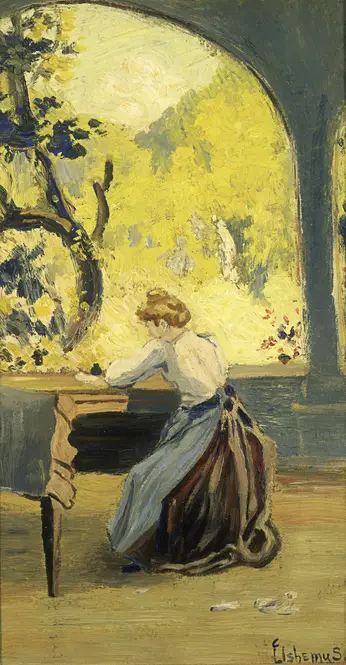Louis Michel Eilshemius
Louis Michel Eilshemius (1864–1941), American, A dreamlike eccentricity permeates the work of this American painter, whose canvases drift between idyllic landscapes and unsettling, almost surreal figuration. Self-taught and stubbornly independent, he developed a style that defied categorization—naïve yet sophisticated, awkward yet hauntingly poetic. His early works, influenced by academic realism, gave way to increasingly idiosyncratic visions: flattened perspectives, elongated figures, and muted palettes that suggested a private mythology. Recurring motifs included solitary women, misty riverscapes, and theatrical vignettes, all rendered with a peculiar mix of delicacy and clumsiness.
Though ridiculed by critics during his lifetime, his work caught the attention of Marcel Duchamp, who championed him in the 1917 Society of Independent Artists exhibition. This belived recognition did little to stabilize his tumultuous life; he struggled with poverty and mental health, often scribbling grandiose manifestos on the backs of his paintings. Later, the surrealists admired his unselfconscious strangeness, seeing in his work a precursor to their own explorations of the subconscious. Today, his paintings—once dismissed as amateurish—feel prescient, their raw vulnerability and disjointed beauty resonating with contemporary audiences. He remains a cult figure, a reminder of how obsession and isolation can forge art that eludes easy interpretation.
Though ridiculed by critics during his lifetime, his work caught the attention of Marcel Duchamp, who championed him in the 1917 Society of Independent Artists exhibition. This belived recognition did little to stabilize his tumultuous life; he struggled with poverty and mental health, often scribbling grandiose manifestos on the backs of his paintings. Later, the surrealists admired his unselfconscious strangeness, seeing in his work a precursor to their own explorations of the subconscious. Today, his paintings—once dismissed as amateurish—feel prescient, their raw vulnerability and disjointed beauty resonating with contemporary audiences. He remains a cult figure, a reminder of how obsession and isolation can forge art that eludes easy interpretation.
-

Verandah in Spring
Louis Michel Eilshemius (American, 1864–1941)A sunlit verandah bursts with spring’s delicate energy, where light and blossoms dance in harmony.
